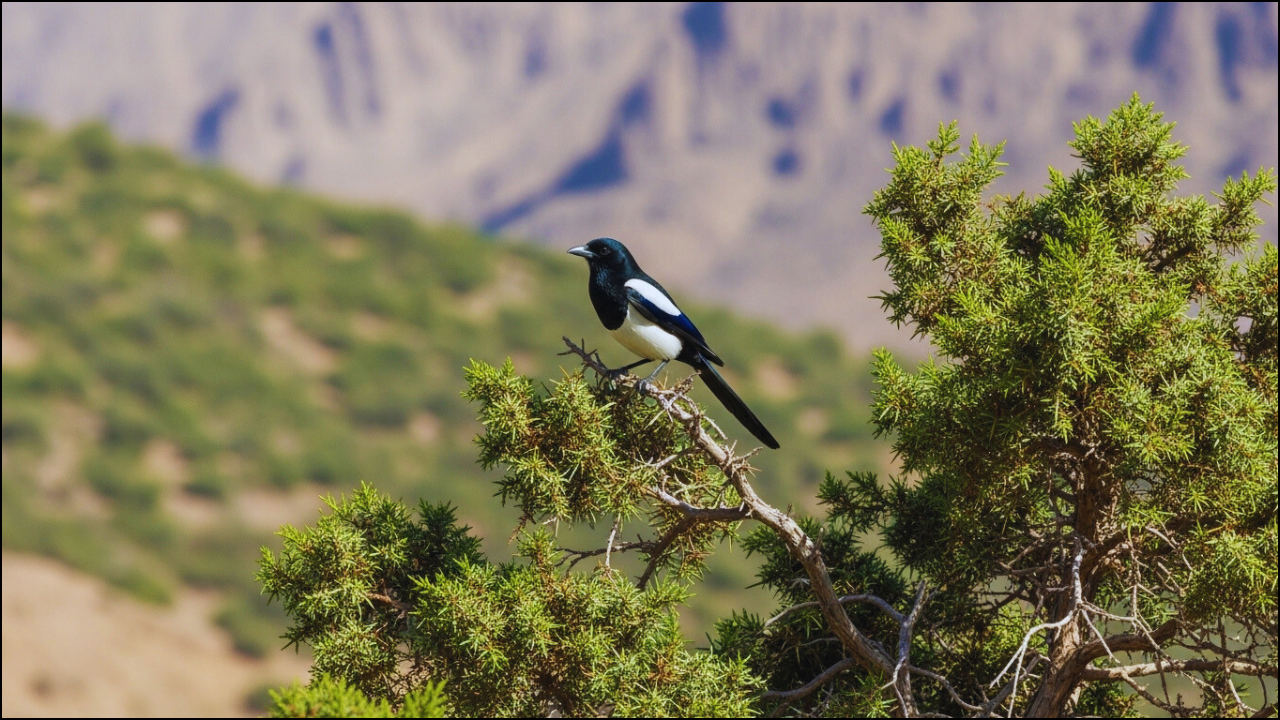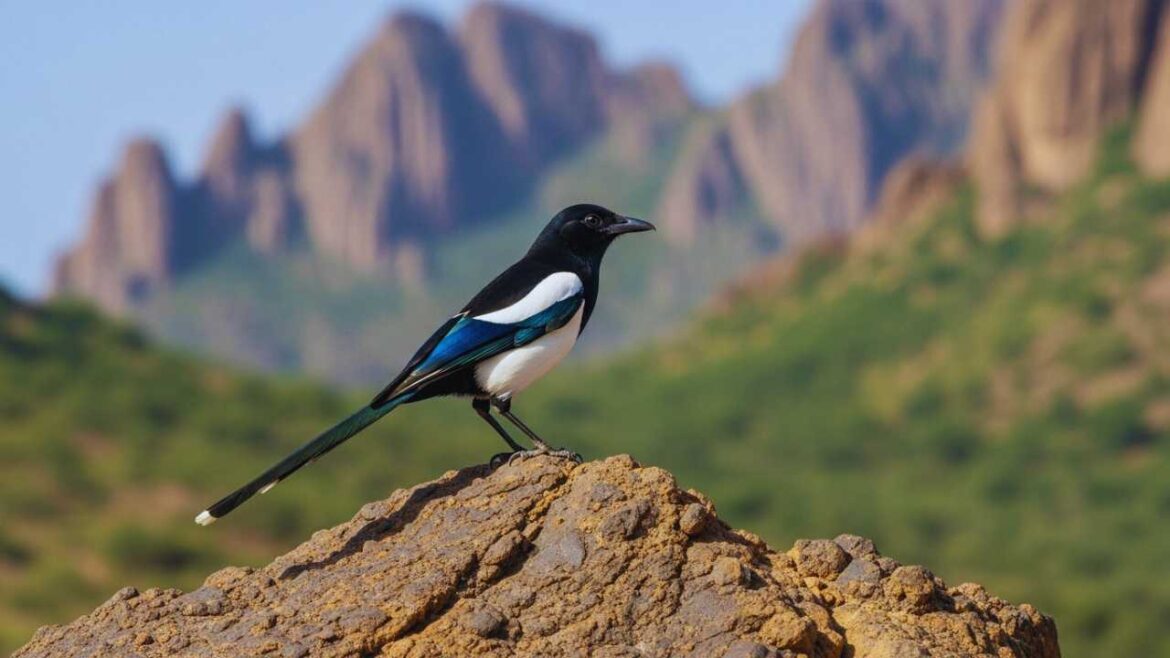Deep in the misty mountains of southwestern Saudi Arabia lives one of the world’s rarest birds. A species so unique that it exists nowhere else on Earth. The Asir Magpie is Saudi Arabia’s only endemic bird, and with fewer than 100 breeding pairs remaining, it’s racing against time to avoid extinction. This remarkable bird’s story is one of survival, intelligence, and hope in the face of overwhelming odds.
Meet Saudi Arabia’s Most Exclusive Resident
The Asir Magpie (Pica asirensis) is truly one of nature’s hidden gems. Unlike its more common magpie cousins found across the globe, this bird has made the Asir Mountains its exclusive home for thousands of years.
What makes the Asir Magpie special:
- Size: 46 cm in length, weighing about 240 grams
- Appearance: Striking black plumage with a distinctive white belly
- Intelligence: Known for exceptional problem-solving abilities and complex communication
- Habitat: Lives only above 2,100 meters in Saudi Arabia’s juniper forests
A Bird That Defies the Desert Stereotype
When most people think of Saudi Arabian wildlife, they imagine desert-adapted creatures. The Asir Magpie breaks that mold entirely, thriving in the kingdom’s unexpected mountain forests.
Where to Find Them
These remarkable birds have chosen some of Saudi Arabia’s most scenic real estate:
- Primary habitat: Shaded juniper forests on south-facing mountain slopes
- Altitude preference: Above 2,100 meters elevation
- Secondary habitats: Cultivated mountain areas and open foothills
- Geographic focus: Concentrated in Tanumah Governorate within the Asir Mountains
The Daily Life of an Asir Magpie
What’s on the Menu?
As opportunistic omnivores, Asir Magpies aren’t picky eaters:
- Invertebrates and insects
- Plant materials and seeds
- Roadkill and carrion
- Human food scraps (when available)
Social Structure
These intelligent birds are surprisingly social:
- Foraging groups: Travel in family units of up to seven birds
- Communication: Use loud, distinctive calls to coordinate with family members
- Activity pattern: Most active during daylight hours
Love and Family Life in the Mountains
The Asir Magpie’s approach to romance and family is both touching and practical.
Breeding Behavior
- Mating system: Monogamous partnerships
- Parenting: Both parents share nest-building and chick-rearing duties
- Nesting season: Follows territorial breeding patterns
Nest Architecture
These birds are master builders:
- Construction: Large, bowl-shaped structures made from twigs
- Interior design: Lined with mud, fine twigs, and rootlets
- Protection: Covered with a dome of twigs, featuring a side entrance
- Location: Built 3-8 meters high in juniper and acacia trees
- Durability: New nests built annually, though old ones may last years
Raising the Next Generation
- Clutch size: Typically 2-5 eggs (exact numbers still being studied)
- Incubation: 21-22 days, handled primarily by females
- Fledgling period: 24-30 days before young birds leave the nest

A Species on the Brink
The Asir Magpie’s story takes a sobering turn when we consider its conservation status.
The Numbers Don’t Lie
- Global population: Fewer than 100 breeding pairs
- Conservation status: Classified as endangered
- Historical range: Once found as far north as Taif, now confined to Asir Mountains
- Population trend: Steadily declining
Why They’re Disappearing
While specific threats are still being studied, the Asir Magpie faces challenges common to many endemic mountain species:
- Habitat loss and fragmentation
- Climate change affecting mountain ecosystems
- Human development in their limited range
- Small population making them vulnerable to random events
Hope Takes Flight: Conservation Efforts
The fight to save the Asir Magpie involves some impressive partnerships and cutting-edge science.
The 2018 Conservation Initiative
Saudi Aramco, working with the Saudi Wildlife Authority and the Smithsonian Institution, launched an ambitious rescue mission:
Research components:
- Population surveys and density mapping
- Habitat use analysis
- Distribution studies
- Advanced GPS tracking of individual birds
- DNA analysis from blood samples
- Individual identification through leg banding
Goals:
- Understand the causes of population decline
- Develop targeted conservation strategies
- Ensure long-term survival of stable populations
Why the Asir Magpie Matters
This small mountain bird represents something much larger than itself.
Scientific Importance
- Evolutionary uniqueness: Represents thousands of years of isolated evolution
- Ecosystem indicator: Health reflects the condition of mountain forest ecosystems
- Research value: Provides insights into Arabian Peninsula biodiversity
Cultural Significance
- National heritage: Saudi Arabia’s only endemic bird species
- Conservation symbol: Represents the kingdom’s commitment to biodiversity protection
- Educational opportunity: Showcases unexpected Saudi Arabian ecosystems
The Bigger Picture: Saudi Arabia as a Bird Haven
The Asir Magpie is just one star in Saudi Arabia’s surprisingly rich avian community:
- Total species: 550 bird species recorded
- Breeding residents: 219 species
- Migrants: 280 species using Saudi Arabia’s strategic location
- Vagrants: 51 rare visitor species
- Threatened species: 27 globally threatened species call Saudi Arabia home
- Regional endemics: 19 species endemic to the Arabian Peninsula
What Happens Next?
The future of the Asir Magpie hangs in the balance, but dedicated conservation efforts offer genuine hope. Success will require continued research, habitat protection, and perhaps most importantly, public awareness and support.
The story of Saudi Arabia’s only endemic bird is far from over. With fewer than 100 breeding pairs representing the entire global population, every individual Asir Magpie matters. These remarkable mountain dwellers remind us that even in our modern world, there are still wild places harboring unique life forms found nowhere else on Earth.
What do you think about conservation efforts for rare species like the Asir Magpie? Have you encountered any unique wildlife in unexpected places? Share your thoughts and experiences in the comments below, and help spread awareness about this incredible bird by sharing this story.
Stay Updated
🔔 Stay updated with the latest Updates and guides:
✅ WhatsApp Channel
☑️ Telegram Channel
Related Articles:
- History of Saudi Arabia: A Comprehensive Guide
- Al-Faqra Mountains: A Hidden Gem in Saudi Arabia
- Hejaz Mountains: A Best Complete Guide
- Ancient Pottery Vessel: A Best Historical Guide
- Arabian Camel: A Comprehensive Guide

